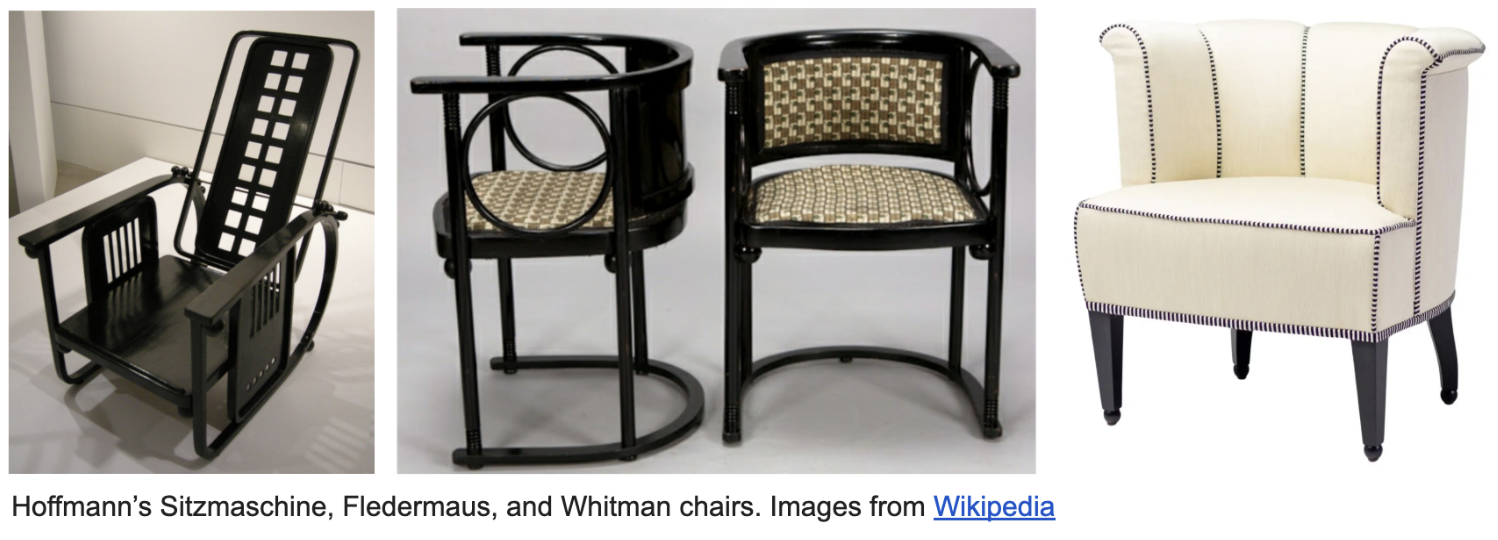The Design Brief® | Volume XXII | HISTORY SERIES: Historic Furniture from Central Europe
©️ Dakota Design Company 2017-2025 | All rights reserved. This content may not be reproduced, distributed, or used without permission.
WRITTEN BY DR. GLORIA for DAKOTA DESIGN COMPANY
In central European countries, such as Germany, Austria, Czechoslovakia, Belgium, the Netherlands, and Denmark, the period of the Renaissance was delayed and not as long-lasting or influential as elsewhere in Europe. Even before that, these countries were not highly prominent within architecture and design as other parts of Europe. But there are several later periods when these countries were very much at the forefront of stylistic architectural and furniture innovations. This post focuses on several notable 19th- and 20th-century periods where important design innovations emerged from these central European countries.
Biedermeier Style in Germany
Soon after the Empire style peaked in France, at the time of Napoleon Bonaparte, at the end of the 18th century (late 1700s) and early 19th century (early 1800s), a unique furniture style emerged in Germany. Later, this style was given the name Biedermeier, and is considered to have taken place from 1815 to 1848.
Biedermeier style employed many of the same stylistic qualities as French Empire furniture, with scrolls and militaristic motifs, but was more simplified and less expensive (for instance, no gold gilding). Styles used a lot of curved lines, and an emphasis was put on the beauty of the wood. The furniture had a bulky, heavy, and masculine quality to it. Although significant detailing was included, the forms exhibited simplicity and stark symmetry. Incorporating both curvaceousness and heft, these pieces possess a unique and easily identifiable quality. Biedermeier style is both understated and restrained, yet also somewhat flamboyant.
Burled wood, which comes from the knotty growths at the base of any species of tree, was often used. While really an imperfection in nature, this tree defect yields wood pieces with a very interesting swirly grain configuration.
Art Nouveau and Vienna Secession
Art Nouveau began about 1892 in Belgium (late 19th century), and the ideas of influential designers made an impact in Austria and the United States. However, it was a short-lived stylistic movement. By 1914, at the start of the First World War, the movement had lost focus and influence, and was replaced by Art Deco as the dominant style in the decorative arts.
Art Nouveau was inspired by the Arts and Crafts movement, which was happening about the same time in England, led by designers such as William Morris. While Morris’ furniture had a simple, naturalistic, and handmade quality (below left), his textile and wallcovering designs were highly organic and fluid, incorporating sinuous curves of plants and flowers, clearly a precursor to Art Nouveau.
Art Nouveau capitalized on the sinuous lines of vines that William Morris had also used, but to a more extreme degree, suggesting movement and mimicking the natural curvaceous lines seen in certain flowers, and on butterflies, swans, peacocks, and dragonflies. In Belgium, architect Victor Horta emerged as a leading proponent of the movement. He designed the Hotel Tassel in Brussels, Belgium, pictured below. Note the whiplash curving lines used throughout.
Other designers also utilized natural organic forms, bird images, and sinuous whiplash lines.
Art Nouveau extended beyond architecture and the decorative arts into graphic design and advertising. Alphonse Mucha, from Czechoslovakia, created theatrical posters, illustrations, and advertisements, focusing almost entirely on beautiful women with long, sinuous hair tendrils.
In Austria, Art Nouveau was known as the Vienna Secession, headed by Austrian designer and architect Josef Hoffmann. In addition to curvilinear forms, he used rectilinear forms, geometric motifs, circles and spheres, and black and white contrasting colors
Modernism in Germany and Denmark
During the Modernist period—or, more specifically, mid-century modern, which literally refers to the middle of the 20th century, 1930-1970—many influential furniture designers originated from Germany and Denmark. Germany was home to the Bauhaus, a well-known art and architecture school that had a profound impact on 20th-century design
One of the most well-known architects and designers associated with the Bauhaus school was the German architect and designer, Ludwig Mies van der Rohe, often simply referred to as Mies. The phrase “Less is More” has been attributed to him, as his architecture and furniture emphasized stark simplicity and minimalism.
In 1929, he designed the groundbreaking Barcelona Pavilion, intended as a model home or exhibition home showcasing what the home of the future could be. This minimalist structure was a significant departure from homes being built anywhere at that time. Comprised of simple, but beautiful materials—polished stone, glass, concrete, and steel—its simplicity and beauty were very inspirational to the Modernist designers who followed.
Mies also designed the furniture for this exhibition home, including his still very popular Barcelona chair, with its distinctive X-shaped steel legs, and the coordinating chaise.
To avoid the rise of Nazism in Germany, Mies emigrated to the United States in 1938 and continued to create very innovative furniture and architecture for decades, particularly in Chicago.
Denmark was an important source of very innovative furniture designs during the Modernist period. Three very influential 20th-century furniture designers came from Denmark: Hans Wagner, Arne Jacobsen, and Verner Panton. Together, they advanced Modernism with furniture that featured clean, pure lines; innovations in shape and form, and attention to the requirements of the human body. Some of the most iconic chair designs of the Modernist period came from these three designers. Through mass production techniques, Danish Modern (aka Scandanavian design) furniture gained significant popularity in the United States during the 1950s and 1960s.
Hans Wagner has been referred to as the master of the chair, because he created almost 500 distinctive chair designs in his lifetime.
Arne Jacobsen was one of the most innovative furniture designers of the Modernist period, through his exploration of shape and form. One can almost imagine him thinking, “Hmmm, what other shape could I make a chair into??” His Egg Chair and Swan Chair are among the most memorable chair designs of the entire mid-century modern period. He also designed the diminutive Ant chair.
Just as with Arne Jacobsen, one can imagine Vernon Panton musing, “What OTHER shape could a chair be???” He designed the Heart chair and Cone chair as well as the very innovative molded plastic stacking chair.
Tubular steel, a relatively new material at the time, provided these designers with much greater latitude in designing chair bases. A single, center support of tubular steel could easily support the needed weight, eliminating the need for the traditional four wooden legs at the corners of the chair base. And plastic, perhaps the most important material innovation of the 20th century, was moldable into a myriad of shapes that could be utilized for chair design.
Central European countries, particularly Germany, Austria, and Denmark, had a significant influence on furniture design at important points during the 19th and 20th centuries.
SOURCES USED:
Ireland, Jeannie. (2018). History of Interior Design, 2nd edition. Fairchild Books
Want The Design Brief® delivered straight to your inbox?
If you liked this article, be sure to sign up for The Design Brief®, our complimentary publication that gives you bite-sized lessons on all the technical interior design topics you didn’t learn (or forgot) from design school—straight from our resident tenured interior design professor!
Looking for more? Keep reading:


























